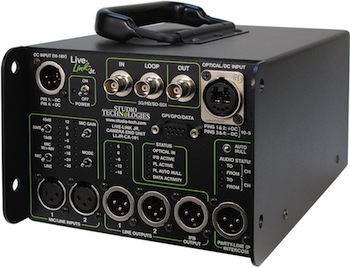Studio Technologies has introduced the new Live-Link Jr. Remote Camera Interface System at InfoComm 2012 (Joseph Electronics Booth C5950).
- “The Live-Link Jr. Remote Camera Interface System was developed to efficiently support single-camera remote production situations, and is especially suited for feeding content to the multiple media outlets now associated with live events, meetings, concerts and the like,” said Gordon Kapes, president of Studio Technologies. “We are constantly out in the field talking to professionals about what equipment and features they would like to have to complete a project. Live-Link Jr. was developed from these conversations and we believe the commercial integration and AV industries will respond positively, as the system solves an abundance of very real production and system deployment problems.”
- Live-Link Jr. is the video, audio, communications and control data link between a camera operator in the field and a production vehicle or fixed installation. The system transports one SDI video signal in each direction: camera end-to-truck end and truck end-to-camera end, supporting SD-, HD- and 3G-SDI data signals. All Live-Link Jr. audio and support signals are transported between camera end and truck end units as embedded SDI data. Linked using just two single-mode optical fibers, Live-Link Jr. delivers operational performance regardless of the distance between the camera end and truck end units — whether hundreds of feet or miles apart. The camera end unit allows for remote powering using hybrid fiber/copper cable, 12 volt DC or Anton/Bauer or “V-Mount” batteries. The truck/studio end unit offers both AC and DC powering capabilities, with failsafe operation from the DC input, should the AC mains fail.
- The camera end unit offers two mic/line inputs that are compatible with microphone or line-level signals. Related features include adjustable input sensitivity, phantom power and level metering. Each input stage can be independently set for compatibility with line-level signals (0 dB gain) or mic signals (gain of 15, 30 or 45 dB). Two balanced line-level outputs are provided on the truck end unit’s back panel and are associated with the camera end unit’s mic/line inputs. Two additional balanced line-level outputs are also located on the truck end unit’s back panel to provide de-embedded analog signals associated with group 1, channels 1 and 2 of the transported SDI signal. These “convenience” outputs allow audio embedded, for example, by a camera connected to the camera end unit to be accessible without the need for an external de-embedder unit at the truck/studio end.
- A 2-channel party-line intercom interface is provided on both the camera end and truck end units, allowing beltpacks to be directly connected and powered. A fully functional camera end-to-truck end “comms” system can be up and running in just minutes. Additionally, a “4-wire” input and output allows direct interconnection with matrix intercom systems. Two line-level audio signals can also be transported from the truck end to the camera end via fiber connection, allowing for IFB communications. The balanced line/IFB inputs are located on the back panel of the truck end unit and allow the connection of a variety of analog audio signals, including talent cueing. The audio quality can support transporting on-air signals. For flexibility, both line-level and “wet” IFB (power and audio) outputs are provided on the camera end unit.
